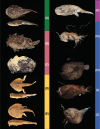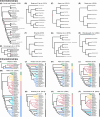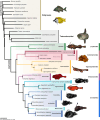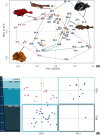A total-evidence phylogenetic approach to understanding the evolution, depth transitions, and body-shape changes in the anglerfishes and allies (Acanthuriformes: Lophioidei)
- PMID: 40315280
- PMCID: PMC12047784
- DOI: 10.1371/journal.pone.0322369
A total-evidence phylogenetic approach to understanding the evolution, depth transitions, and body-shape changes in the anglerfishes and allies (Acanthuriformes: Lophioidei)
Abstract
The anglerfishes and allies (Lophioidei) are a diverse group of fishes with over 400 carnivorous species that are renowned for their remarkable hunting behavior employing a modified first dorsal-fin spine to lure prey and adaptations such as "pseudo-walking," bioluminescence, and parasitic sexual dimorphism. Gaining a comprehensive understanding of their evolutionary history has been challenging, as previous studies using DNA sequence data or morphological traits have provided either inconsistent or contradictory results. We present a new comprehensive phylogenetic framework for the evolution of the Lophioidei, combining ultraconserved elements (UCEs), mitochondrial DNA sequence data, and morphological characters. Our findings reveal a monophyletic Lophioidei, positioned as the sister group to the Tetraodontoidei within a broader acanthuriform radiation. Goosefishes (Lophioideo) emerge as the stem anglerfish lineage, forming a sister clade with frogfishes (Antennarioideo) + batfishes (Ogcocephaloideo) and coffinfishes (Chaunacoideo) + deep-sea anglerfishes (Ceratioideo). We expanded the Antennariidae to include all previous frogfish (antennarioid) families as subfamilies while proposing a new subfamily, Fowlerichthyinae, to produce a stable monophyletic taxonomy for the Antennarioideo. Further, we evaluated previously and newly proposed morphological characters to diagnose the Lophioidei and Lophioideo. Our investigations demonstrated that several traditional synapomorphies are no longer diagnostic for the Lophioidei. Based on our phylogeny, a geometric morphometric analysis revealed significant differences in body shape among lophioid infraorders, especially in frogfishes and deep-sea anglerfishes, indicating the importance of habitat transitions on body-shape evolution. This study, integrating genome-scale nuclear, mitochondrial, and morphological data, provides a total-evidence perspective on the evolutionary history of lophioids and sheds light on their specializations and body-shape changes as they transitioned across and within environments.
Copyright: © 2025 Maile et al. This is an open access article distributed under the terms of the Creative Commons Attribution License, which permits unrestricted use, distribution, and reproduction in any medium, provided the original author and source are credited.
Conflict of interest statement
The authors have declared that no competing interests exist.
Figures












References
-
- Nelson JS, Grande TC, Wilson MVH. Fishes of the world. 5th ed. Hoboken: John Wiley & Sons; 2016.
-
- Fricke R, Eschmeyer WN, Laan R. Eschmeyer’s catalog of fishes: genera, species, references. 2024. Available: http://researcharchive.calacademy.org/research/ichthyology/catalog/fishc...
-
- Linnaeus C. Systema Naturae per regna tria naturae, secundum classes, ordines, genera, species, cum characteribus, differentiis, synonymis, locis. 10th ed. Holmiae: Laurentius Salvius; 1758. Available: https://www.biodiversitylibrary.org/page/6340395
-
- Rafinesque CS. Indice d’ittiologia siciliana; ossia, catalogo metodico dei nomi latini, italiani, e siciliani dei pesci, che si rinvengono in Sicilia disposti secondo un metodo naturale e seguito da un appendice che contiene la descrizione de alcuni nuovi pesci sicilian. Messina. 1810. Available: https://www.biodiversitylibrary.org/page/6340395
-
- Cuvier G. Le règne animal distribué d’après son organisation: pour servir de base à l’histoire naturelle des animaux et d’introduction à l’anatomie comparée. Vol. 2. Paris: Chez Déterville; 1817. doi: 10.5962/bhl.title.49223 - DOI
MeSH terms
Substances
LinkOut - more resources
Full Text Sources

